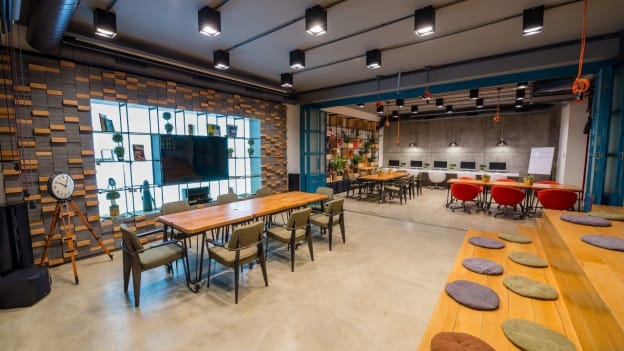'Necessary revamp': Why organisations must redesign workplace layout to maximise outcomes in post-Covid era

The role of the workspace in developing the organisation's identity has become more significant in the past few years - and more so with the changing demographic and culture of the workforce.
With the Covid-19 pandemic upending our lives, businesses have adapted to a flexible work culture. This further raises the need to rethink the way offices work and how their layouts are going to make sense in the new normal.
“In recent years, office desks have shrunk given the widespread adoption of technology. Further with Covid-19 ramifications, businesses have suffered huge losses and downsized their workforce," says Kunal Sharma, founder and CEO of interior design venture Flipspaces, which leverages technology and workplace strategy to serve Fortune 500 companies, startups, and coworking spaces across the globe.
"Workspaces now need to be adaptable to ensure they stay ahead of the curve and the use of technology would only help them adapt to the new normal and beyond.
“Today’s offices are meant to be spaces that exude culture, comfort and a sense of belonging,” he adds.
“With big tech replacing human effort at a rapid pace, the only qualities that are irreplaceable are creativity and innovation. Today's workspaces are built to nurture and support these functionalities,” says Nidhi Marwah, group managing director at premium flexible workspace provider The Executive Centre.
Re-engineering the office structure serves as a catalyst for better communication, ideation, and execution. Marwah says it is vital for organisations to not impede the changing requirements of today's workforce and be adaptable to the evolution of work, along with the infrastructure needed to support it.
“The technology used in business operations has become more space efficient over the last 10 years, which makes the workforce more mobile, agile and allows more space for collaboration. Most importantly, across industries, the one characteristic of all workspace strategies is agility and adaptability to changing business operation strategies,” she adds.
GSK Consumer Healthcare recently adopted smart working 4.0 - a technology driven smart office that monitors and simultaneously responds to the performances - with its new work space in Gurugram (India).
The office has been designed incorporating learnings from the organisation’s recent work-from-home experience, keeping a strong focus on employment empowerment to achieve greater productivity as well as improve the working environment through 50% workstations with ergonomic seating and 50% collaborate and meeting spaces catering to 300 employees.
To promote stronger professional connections, the company has constructed tailored etiquette to support the Smart Working 4.0 which will not be just limited to teams but also includes workstations, meeting rooms, focused rooms and quiet spaces/libraries for appropriate use of spaces. Employees will have access to enhanced facility management through assistance to pre- booking and wayfinding (opt-in) services.
Employees' health will be closely monitored to ensure better efficiency and overall workplace experience. There is special focus on facilities for differently-abled workforce with inclusion of ramps for easy access and movement of wheelchairs and toilet accessibility. Medical rooms have been specially designed to give employees a vital break, as and when necessary.
Break-out sessions and leisure time has been given equal importance with spaces like the cafeteria, lounge, and tuck shop. Most importantly, it will ensure an increase in scrutiny on carbon footprints and create sustainable measures as well.
“We are excited as we move into a new collaborative technology backed workspace that encourages people to come back to the office. Through our smart working 4.0 proposition, our mission is to ensure a hybrid environment that keeps the employee interests at heart and motivates them to give their 100% through increased collaboration. This new space with help in connecting people, maximising convenience and define the working experience of the future,” says Priyank Parakh, HR Head, GSK Consumer Healthcare,India.
Like GSK, many organisations have made significant changes to prepare for the post-pandemic workplace.
‘Need to rethink workplace not a choice but a business function’
As we enter the post-pandemic world, it is evident that the nature of the office is forever evolving and there is no set blueprint for workspace strategies.
“The need to rethink the workplace is not a choice but a business function,” says Marwah.
Due to the challenges of the last few years, organisations have had to go back to the drawing board and rethink the functionality, need, and structure of office spaces.
“With this overhaul has come the necessity to factor in the new demographic of the workforce - after millennials, the composition of the workforce will be dominated by Gen Z. While organisations gear up to welcome this new workforce, the office becomes the first reflection of the change in organisational culture,” she adds.
Marwah adds that office design needs to be built for nurturing creativity, dismantling hierarchy, designed for inclusivity and a personification of the company culture.
“This means, minimised focus on corner office views and amplification of collaborative spaces which makes the new workforce feel welcome, acknowledged, and supported. Despite the demographic, employee well-being and focus on physical and mental wellness is now a priority. This dictates the need for amenities, such as health and fitness centres, wellness rooms, access to a creche and mental health experts,” she adds.
The nature of the workspace has evolved ever since the pandemic, and not just with Gen Z influencing the overall brief of the design.
“Employees now want to feel safe and secure with regards to premises they’re currently working at, but to also feel that they’re in a more collaborative, and open environment which fosters productivity and culture. In this regard, a startup or SME or any business for that matter has to solve for the challenge of creating a differentiated identity for two key stakeholders - the clients it hopes to attract and the talent pool it looks to hire. Having a differentiated space which is in sync with a brand’s ethos and vision is a key factor in breaking through the clutter in both these highly competitive functions,” says Sharma of Flipspaces.
Emerging trends in the post-pandemic workspaces
Workforce trends like the Gig Economy and the Great Resignation have proven that pay scale and cosmetic changes in policies are not enough to retain the Gen Z workforce.
“Unlike millennials, Gen Z will not contest policies or demand change but opt for alternatives. Organisations are still comprehending the needs of the new workforce and hence, keeping workspace strategies fluid,” says Marwah, sharing a few emerging trends in the workplaces emerging across all sectors.
The need for tangible change is the first. Gen Z workforce is fast to dismiss changes that are cursory in nature and value well-defined strategies that help day-to-day functionality.
Workforce strategies that are built to champion flexibility are a big draw. Multiple touchpoints within the same city where employees can step into work, collaborate, and access required infrastructure, are expected.
Striking a balance between privacy and collaboration is key too.
With the workforce returning to office after work from home, the office design needs to facilitate options of both privacy and social interaction, equally. While interaction and collaboration need to be catered to, working in isolation is just as important for individuals.
It means maintaining control over your immediate environment and privacy to work, and on an organisational level, privacy of the workspace gives the company control over culture and brand.
















